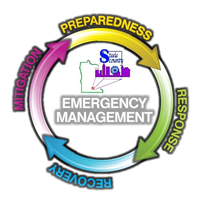Smoke alarms are the residential fire safety success story of the past quarter century. Smoke alarm technology has been around since the 1960s. But the single-station, battery-powered smoke alarm we know today became available to consumers in the 1970s, and since then, the home fire death rate has been reduced by half. Most states have laws requiring them in residential dwellings.Important: Working smoke alarms are essential in every household. It is necessary to practice home fire drills to be certain everyone is familiar with the smoke alarm signal, and to determine if there are any obstacles to a quick and safe evacuation (including the inability for some to awaken to the smoke alarm signal).
Facts & Figures
- A 2004 U.S. telephone survey found that 96% of the households surveyed had at least one smoke alarm.
- Roughly half of home fire deaths result from fires in the small percentage of homes with no smoke alarms.
- Homes with smoke alarms (whether or not they are operational) typically have a death rate that is 40-50% less than the rate for homes without alarms.In one-quarter of the reported fires in homes equipped with smoke alarms, the devices did not work.
- Households with non-working smoke alarms now outnumber those with no smoke alarms.
- Why do smoke alarms fail? Most often because of missing, disconnected or dead batteries.
Source: NFPA’s “U.S. Experience with Smoke Alarms and Other Fire Detection/Alarm Equipment.
Installation and Maintenance Tips
- Install smoke alarms on every level of your home, including the basement, making sure that there is an alarm outside every separate sleeping area. New homes are required to have a smoke alarm in every sleeping room and all smoke alarms must be interconnected.
- Hard-wired smoke alarms operate on your household electrical current. They can be interconnected so that every alarm sounds regardless of the fire’s location. This is an advantage in early warning, because it gives occupants extra time to escape if they are in one part of the home and a fire breaks out in another part. Alarms that are hard-wired should have battery backups in case of a power outage, and should be installed by a qualified electrician.
- If you sleep with bedroom doors closed, have a qualified electrician install interconnected smoke alarms in each room so that when one alarm sounds, they all sound.
- If you, or someone in your home is deaf or hard of hearing, consider installing an alarm that combines flashing lights, vibration and/or sound.
- Mount smoke alarms high on walls or ceilings (remember, smoke rises). Ceiling mounted alarms should be installed at least four inches away from the nearest wall; wall-mounted alarms should be installed four to 12 inches away from the ceiling.
- If you have ceilings that are pitched, install the alarm near the ceiling’s highest point.
- Don’t install smoke alarms near windows, doors, or ducts where drafts might interfere with their operation.
- Never paint smoke alarms. Paint, stickers, or other decorations could keep the alarms from working.
A life-saving test: check your smoke alarms regularly
- Test your smoke alarms once a month, following the manufacturer’s instructions.
- Replace the batteries in your smoke alarm once a year, or as soon as the alarm “chirps” warning that the battery is low. Hint: schedule battery replacements for the same day you change your clocks from daylight savings time to standard time in the fall.
- Never “borrow” a battery from a smoke alarm. Smoke alarms can’t warn you of fire if their batteries are missing or have been disconnected.
- Don’t disable smoke alarms even temporarily. If your smoke alarm is sounding “nuisance alarms,” try relocating it farther from kitchens or bathrooms, where cooking fumes and steam can cause the alarm to sound.
- Regularly vacuuming or dusting your smoke alarms, following the manufacturer’s instructions, can keep them working properly.
- Smoke alarms don’t last forever. Replace yours once every 10 years. If you can’t remember how old the alarm is, then it’s probably time for a new one.
- Consider installing smoke alarms with “long-life” (10-year) batteries.
- Plan regular fire drills to ensure that everyone knows exactly what to do when the smoke alarm sounds. Hold a drill at night to make sure that sleeping family members awaken at the sound of the alarm. Some studies have shown that some children may not awaken to the sound of the smoke alarm. Know what your child will do before a fire occurs.
- If you are building a new home or remodeling your existing home, consider installing an automatic home fire sprinkler system. Sprinklers and smoke alarms together cut your risk of dying in a home fire 82 percent relative to having neither – a savings of thousands of lives a year.
- Ionization-type smoke alarms have a small amount of radioactive material between two electrically charged plates, which ionizes the air and causes current to flow between the plates. When smoke enters the chamber, it disrupts the flow of ions, thus reducing the flow of current and activating the alarm.
- Photoelectric-type alarms aim a light source into a sensing chamber at an angle away from the sensor. Smoke enters the chamber, reflecting light onto the light sensor; triggering the alarm.
Sensing systems
Most smoke alarms use one of two common sensing systems for detecting a fire.
Ionization vs. photoelectric
Photoelectric alarms respond slightly faster to smoldering fires; ionization alarms respond slightly faster to flaming fires. Since, as a practical matter; you can not predict the type of fire that will occur; the slight difference is irrelevant. Either type of alarm will detect nearly every type of fire quickly. Some manufacturers offer dual-chamber alarms that use both sensor systems.
Updated 10-Feb-2020
